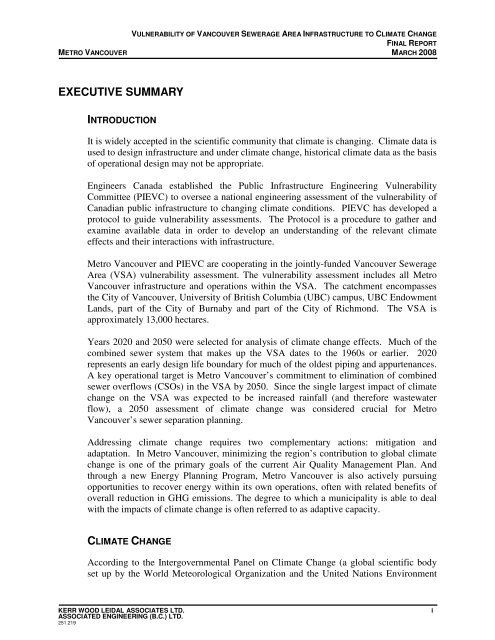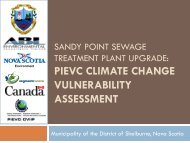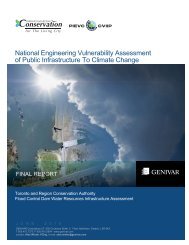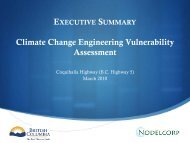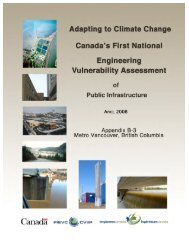EXECUTIVE SUMMARY - Vulnerability Committee
EXECUTIVE SUMMARY - Vulnerability Committee
EXECUTIVE SUMMARY - Vulnerability Committee
Create successful ePaper yourself
Turn your PDF publications into a flip-book with our unique Google optimized e-Paper software.
VULNERABILITY OF VANCOUVER SEWERAGE AREA INFRASTRUCTURE TO CLIMATE CHANGEFINAL REPORTMETRO VANCOUVER MARCH 2008<strong>EXECUTIVE</strong> <strong>SUMMARY</strong>INTRODUCTIONIt is widely accepted in the scientific community that climate is changing. Climate data isused to design infrastructure and under climate change, historical climate data as the basisof operational design may not be appropriate.Engineers Canada established the Public Infrastructure Engineering <strong>Vulnerability</strong><strong>Committee</strong> (PIEVC) to oversee a national engineering assessment of the vulnerability ofCanadian public infrastructure to changing climate conditions. PIEVC has developed aprotocol to guide vulnerability assessments. The Protocol is a procedure to gather andexamine available data in order to develop an understanding of the relevant climateeffects and their interactions with infrastructure.Metro Vancouver and PIEVC are cooperating in the jointly-funded Vancouver SewerageArea (VSA) vulnerability assessment. The vulnerability assessment includes all MetroVancouver infrastructure and operations within the VSA. The catchment encompassesthe City of Vancouver, University of British Columbia (UBC) campus, UBC EndowmentLands, part of the City of Burnaby and part of the City of Richmond. The VSA isapproximately 13,000 hectares.Years 2020 and 2050 were selected for analysis of climate change effects. Much of thecombined sewer system that makes up the VSA dates to the 1960s or earlier. 2020represents an early design life boundary for much of the oldest piping and appurtenances.A key operational target is Metro Vancouver’s commitment to elimination of combinedsewer overflows (CSOs) in the VSA by 2050. Since the single largest impact of climatechange on the VSA was expected to be increased rainfall (and therefore wastewaterflow), a 2050 assessment of climate change was considered crucial for MetroVancouver’s sewer separation planning.Addressing climate change requires two complementary actions: mitigation andadaptation. In Metro Vancouver, minimizing the region’s contribution to global climatechange is one of the primary goals of the current Air Quality Management Plan. Andthrough a new Energy Planning Program, Metro Vancouver is also actively pursuingopportunities to recover energy within its own operations, often with related benefits ofoverall reduction in GHG emissions. The degree to which a municipality is able to dealwith the impacts of climate change is often referred to as adaptive capacity.CLIMATE CHANGEAccording to the Intergovernmental Panel on Climate Change (a global scientific bodyset up by the World Meteorological Organization and the United Nations EnvironmentKERR WOOD LEIDAL ASSOCIATES LTD.ASSOCIATED ENGINEERING (B.C.) LTD.251.219i
VULNERABILITY OF VANCOUVER SEWERAGE AREA INFRASTRUCTURE TO CLIMATE CHANGEFINAL REPORTMARCH 2008METRO VANCOUVERProgram), the warming that has been experienced over the last half century is likelywithout precedent in at least the past 1,300 years. For the purposes of this project,climate change modelling was performed by Ouranos (a Quebec-based climatologyresearch consortium) using the Canadian Regional Climate Model to quantify expectedchanges to various climate factors.In general, all precipitation indices suggest that there will be an increase in total rainfallamount, and in the frequency and magnitude of rainfall events. In addition, modellingprojects consistently increasing temperature trends at both the 2020 and 2050 horizons,implying that snowfall will decrease.Estimated global sea level rise by Ouranos is 0.14 m by the 2050s and 0.26 m by the2080s. The most recent report from the IPCC has a range in predicted sea level rise by2100 of between 0.2 m and 0.6 m. Locally, in research conducted by Natural ResourcesCanada, it is reported that the Fraser River delta areas (Richmond and Delta) are sinkingat a rate of 1 mm/yr to 2 mm/yr, while other areas (Vancouver, Burnaby, Surrey,Tsawwassen Heights) are uplifting at a rate of 0 mm/yr to 1 mm/yr. Therefore, forcertain areas of the VSA such as Iona Island, global sea level rise will be aggravated by asinking land surface, increasing the relative sea level rise.Monthly average minimum and maximum temperatures are predicted to increase by1.4°C to 2.8°C by the 2050s.A summary of climate events is outlined below.Summary of Climate Events.Intense RainClimate EventTotal Annual / Seasonal RainSea Level ElevationExpected ChangeIncrease in 1-day maximum rainfall:17% by 2050s (Ouranos) 1Increase in total annual precipitation:14% by 2050s (Ouranos, addendum)Increase in global sea level elevation 2 :0.26 m by 2080s (Ouranos) to 1.6 m by 2100 (Rohling et al, 2007)Storm Surge Not quantified. Likely to increase 3 .FloodsTemperature (extreme high)DroughtWind (extremes, gusts)Not quantified. Likely to increase.Increases in monthly maximum temperature:1.4°C to 2.8°C by 2050s (Ouranos)Modelling is inconclusive in trend.Average maximum length of dry spell may increase by 0.25 days by2050s (Ouranos)Not quantified. Likely to increase.Notes:1. Estimate is based on total precipitation, which is assumed to be approximately equivalent to rainfall in the VSA.2. Does not include local effects such as subsidence and atmospheric effects.3. Storm surge is a significant contributor to extreme high water events and therefore lack of quantitative data is acritical information gap.iiKERR WOOD LEIDAL ASSOCIATES LTD.ASSOCIATED ENGINEERING (B.C.) LTD.251.219
VULNERABILITY OF VANCOUVER SEWERAGE AREA INFRASTRUCTURE TO CLIMATE CHANGEFINAL REPORTMETRO VANCOUVER MARCH 2008According to Ouranos, climate scenarios are difficult to produce for certain highlylocalized events (wind gusts, tornadoes, and thunderstorms) or events where processesare complex and depend on a number of factors (hurricanes, ice storms). Therefore,quantitative predictions of wind speed were not provided.As described in more detail in Section 2, there are a number of uncertainties andassumptions involved in the climate projections listed above and these reflect onlylimited possible future scenarios for GHG emissions. In addition, regional climate isaffected by large-scale oscillations known as: El Niño/Southern Oscillation (ENSO); and Pacific Decadal Oscillation (PDO).ENSO is a well-known phenomenon characterized by an east-west shifting pattern intropical sea surface temperatures. The time scale of the shifts is relatively short: cycleslast from 2 to 7 years. Generally, El Niño winters are associated with decreasedprecipitation in southwestern British Columbia. The reverse trend occurs during La Niñaevents.The PDO operates over the entire Pacific basin on a decadal timescale. Phases maypersist for about 20 years to 35 years. The PDO shifted to a warm phase in 1976. Forcoastal B.C., the warm phase generally results in thinner snowpacks due to highertemperatures and generally a greater percentage of precipitation in the form of rain. Aconsensus has not yet been reached on whether the PDO has shifted to a cool phase.VANCOUVER SEWERAGE AREA (VSA)The VSA is largely a combined sewer system. Combined sewers are an older type ofcollection system that carry both wastewater and stormwater in the same pipe. Combinedsewers were less expensive to install and maintain when they were built, generally priorto the 1960’s. During heavy rainfall, combined sewers can overflow directly into anearby waterway such as the Fraser River or Vancouver Harbour, producing a CSO. Thisoverflow provides a “safety valve” that prevents back-ups of untreated wastewater intohomes and businesses, flooding in city streets, or bursting underground pipes.Metro Vancouver’s plan is to reduce, then eliminate, CSOs through the process ofgradual conversion to a separated sewer system. Metro Vancouver has committed toelimination of CSOs by 2050 in the 2002 Liquid Waste Management Plan (LWMP). TheLWMP also commits Metro Vancouver to upgrade Iona Island Wastewater TreatmentPlant (IIWWTP) to full secondary treatment no later than 2020. This pilot study istimely, as a planned revision of the LWMP is currently underway.The VSA is served by the IIWWTP, the second largest wastewater treatment plant inMetro Vancouver. The design peak wet-weather flow (PWWF) of the IIWWTP is 17KERR WOOD LEIDAL ASSOCIATES LTD.ASSOCIATED ENGINEERING (B.C.) LTD.251.219iii
VULNERABILITY OF VANCOUVER SEWERAGE AREA INFRASTRUCTURE TO CLIMATE CHANGEFINAL REPORTMARCH 2008METRO VANCOUVERm 3 /s. The plant provides primary treatment to wastewater from approximately 600,000people before discharging it through a 7 km, deep-sea outfall into the Strait of Georgia.The plant opened in 1963 and has been expanded six times for growth and treatmentupgrades allowing more than 200 billion litres of wastewater to be treated here in 2001.INFRASTRUCTURE ASSESSMENTAn important part of the Protocol is a qualitative assessment in which professionaljudgment and experience are used to determine the likely effect of individual climateevents on individual components of the infrastructure.COMBINED SEWERSIt is certain that increased rainfall intensities and volumes will lead to increased flows inthe combined sewers in the absence of other mitigating system changes (e.g. increasedefforts at green infrastructure). The effect will be reduced capacity to convey sanitaryflow to the IIWWTP; as a result, CSOs will be more frequent and discharge greatervolumes.In order to find a relationship between total CSO and rainfall amount, monthly CSOvolume was plotted against average monthly rainfall. Based on the derived linearrelationship, approximately 30% of the monthly rainfall overflows, regardless of season.The Ouranos climate scenario report projects a seasonal rainfall increase of 18% for theDecember-January-February period by 2050. This provides an indication that additionalsewer separation effort may be required to meet Metro Vancouver’s CSO eliminationgoals. Further study is recommended to identify appropriate measures to meet thesegoals (which may include adaptive management, along with hydrologic and hydraulicmodelling).As the combined system is increasingly separated, inflow and infiltration (I&I) willbecome the primary concern with increasing rainfall intensities and volumes.PUMP STATIONSIncreased flows at the pump stations may exceed pump station capacity, which couldresult in overflows locally or upstream. The health and environmental impact would beconsidered severe, but based on current operation the probability is low.IONA ISLAND WASTEWATER TREATMENT PLANTHydraulic constraints within the collection system physically limit the amount of wetweatherwastewater flow that can be conveyed to the IIWWTP, and under the existingLWMP, the planned maximum capacity of the plant is 17 m 3 /s. Therefore, even thoughclimate change may result in an increase in the magnitude and frequency of intenserainfall events and thus increase the potential to generate wet-weather flows, higher peakivKERR WOOD LEIDAL ASSOCIATES LTD.ASSOCIATED ENGINEERING (B.C.) LTD.251.219
VULNERABILITY OF VANCOUVER SEWERAGE AREA INFRASTRUCTURE TO CLIMATE CHANGEFINAL REPORTMETRO VANCOUVER MARCH 2008flow rates are not expected to be received at the IIWWTP. Over time, some of thereductions to peak flow in the regional system as a result of sewer separation will bepartially offset by other factors such as population growth and age-related inflow andinfiltration rate decay.However, more frequent wet-weather events (i.e. events per year) could impact thetreatment process in other ways. For example, primary clarification performance may bereduced during wet-weather flow events, which could result in more days per year withincreased contaminant mass loading to the marine environment in the short-term, and tothe secondary treatment system in the long-term. Similarly, grit removal efficiencies arenotably reduced during high-flow events.In addition, increased frequency of such events would reduce process redundancy“windows” (e.g. clarifiers and screens taken out of service for maintenance). Thissituation could leave the IIWWTP with greater exposure to operations difficulties andmore frequent events with increased primary effluent loading.An increase in the average sea level would impact IIWWTP effluent disposal hydraulics.Here the primary context is the additional energy needed to pump effluent through themarine outfall due to the increase in the static head. Given the sea level predictions, it ishighly probable that there will be a climate effect on this infrastructure component.Overall, a low response severity factor was selected for the assessment.Increases in storm surge, and associated static head, will also impact the effluent outfallsystem from an internal jetty conduit/outfall pipe pressure perspective. The severity ofthis response was deemed to be critical since information exists that suggests the jettyconduit structure is under designed for the original design conditions.Most of the IIWWTP site is above the recently estimated 2.9 m geodetic elevation totalwater level (i.e. 1:200 yr return frequency winter storm surge with high tide combinedwith a Fraser River winter flood, for a 95% confidence interval but excluding climatechange and wind wave effects) (nhc, 2006). The same conclusion applies to a 3.5 melevation that includes an assumed 0.6 m freeboard. However, based on availabledrawings, much of the site, including the access road, appears to be only minimallyhigher in elevation than the 3.5 m level. Factoring in the change in average sea level riseand land sinking, as well as potential wind wave effects, suggests that little margin maybe available in the future.OTHER VULNERABILITY FACTORSOther factors influencing infrastructure vulnerability are noted as follows.Sewer Separation. It was correctly pointed out by Metro Vancouver staff that thereduction in sewer flow from sewer separation will, at many locations, be vastly greaterthan the increase due to climate-based rainfall effects. Sewer separation will significantlydecrease peak flows in the collection system and to the IIWWTP. Note that some MetroKERR WOOD LEIDAL ASSOCIATES LTD.ASSOCIATED ENGINEERING (B.C.) LTD.251.219v
VULNERABILITY OF VANCOUVER SEWERAGE AREA INFRASTRUCTURE TO CLIMATE CHANGEFINAL REPORTMARCH 2008METRO VANCOUVERVancouver regional sewers will eventually be turned over to the City of Vancouver(COV) for stormwater conveyance, and some regional sewers will likely remain forsanitary sewer conveyance to the IIWWTP. Since the separation program is still in itsearly stages, a unique opportunity exists to adequately size the separate stormwater andsanitary sewers for the effects of climate change.Long Range Plans. Construction projects that are part of long range plans will improvesystem operations, presumably increasing the ability to manage CSOs.Infrastructure Replacement. Replacement of aging infrastructure decreases the risk ofsystem blockages and provides the opportunity to install larger mains or separatesystems.Green Infrastructure. Increasing efforts at building green infrastructure may be used toincrease resiliency in adapting to climate change. Metro Vancouver has completedsignificant efforts studying and promoting green infrastructure over the past number ofyears, with the overarching goal of net environmental benefits at a watershed scale.Green infrastructure initiatives are also expected to form a significant component of theupdated LWMP, currently under development.Inflow & Infiltration Reduction and Age Based Rate Decay. Sanitary sewer loads candecrease with inflow & infiltration reduction programs (at the municipal or regionallevel), but generally increase due to material deterioration over time.Population Growth. Population growth will increase sanitary sewer loading over theentire study period. The COV is planning for an increase from 580,000 in 2006 to675,000 in 2021.Land Use. Planned densification can increase impervious area, leading to more runoffand combined sewer loading.Water Conservation. Water conservation programs reduce indoor water use, decreasingsanitary loading.Seismic Events. Landslides or ground shifting caused by seismic events break ordegrade infrastructure integrity.CONCLUSIONSIn general, it is noted that the VSA is fortunately situated with respect to climate changeeffects relative to other locations in Canada. Vancouver rarely experiences extreme orcatastrophic weather events such as ice storms, tornadoes, drought or extreme cold.Perhaps the greatest magnitude threat is flooding of the Fraser River, and many predictthis risk to decline in response to climate change.viKERR WOOD LEIDAL ASSOCIATES LTD.ASSOCIATED ENGINEERING (B.C.) LTD.251.219
VULNERABILITY OF VANCOUVER SEWERAGE AREA INFRASTRUCTURE TO CLIMATE CHANGEFINAL REPORTMETRO VANCOUVER MARCH 2008The climate factors identified as threats to infrastructure vulnerability will be evidencedas gradual changes. In fact, the greatest pressure to initiate adaptive action comes notfrom climate change, but from timing of planned infrastructure improvement plans suchas the treatment plant upgrades and combined sewer separation program. So whileclimate change effects may reveal vulnerabilities, Metro Vancouver is in an ideal positionto proactively mitigate and adapt to these challenges.The key priorities with respect to climate change adaptation in the collection systemcentre on increased rainfall and the associated potential increase in sewer flow, bothunder combined and separate sewer configurations. Accelerated separation may benecessary to achieve the target of CSO elimination by 2050. The extent of the workrequired requires additional study.The vulnerabilities judged to be of the highest priority at the treatment plant are thoseassociated with the effluent disposal system and the IIWWTP site itself because of thestorm surge climate variable.While ranked as lower priorities, the potential impacts of an increase in average sea levelon the IIWWTP site and associated infrastructure are also important due to the significantuncertainty and wide range in predicted future increases in mean sea level. Additionalstudy is required to develop more detailed information and conduct detailed analyses inthe context of these potential vulnerabilities.There are several lower-ranked potential treatment system vulnerabilities due toprecipitation-related climate variables that potentially exist independent of the LWMPdesign limit of 17 m3/s. These vulnerabilities are related to facility capacity andredundancy, which in turn affects capacity. At this point there is considerable uncertaintyin the significance (i.e. response severity) of these vulnerabilities, particularly given therelative magnitude of the estimated climate effects and the potential ability of MetroVancouver’s sewer separation policy to mitigate these vulnerabilities. Additional studyto develop the relationship between these climate variables and the resultant impact onwet-weather wastewater flows may provide enhanced information to assess potentialimpacts on the treatment system. However, given Metro Vancouver’s planned secondarytreatment program for the VSA, a more practical approach is to deal with thesevulnerabilities as the upgraded treatment is being planned and designed. In this case,Metro Vancouver would consider and account for potential changes in infrastructurecapacity as part of the secondary treatment program development, and in the context ofother uncertainties (e.g. sewer separation, future population growth, water consumptionreduction), without explicitly conducting additional specific study.The current capacity of standby power available at the IIWWTP is already avulnerability, which is anticipated to be further exaggerated by climate change. MetroVancouver should consider the need for remedial action to address this vulnerability.KERR WOOD LEIDAL ASSOCIATES LTD.ASSOCIATED ENGINEERING (B.C.) LTD.251.219vii
VULNERABILITY OF VANCOUVER SEWERAGE AREA INFRASTRUCTURE TO CLIMATE CHANGEFINAL REPORTMARCH 2008METRO VANCOUVERGiven the age of the IIWWTP infrastructure, it is recommended that the additionalstudies required consider the remaining service life of the components and in the contextof other potential issues (e.g. seismic). Even if climate change-related vulnerabilities aredeemed to exist, they may be overshadowed by other issues that when resolved cansimultaneously address climate vulnerabilities.viiiKERR WOOD LEIDAL ASSOCIATES LTD.ASSOCIATED ENGINEERING (B.C.) LTD.251.219


